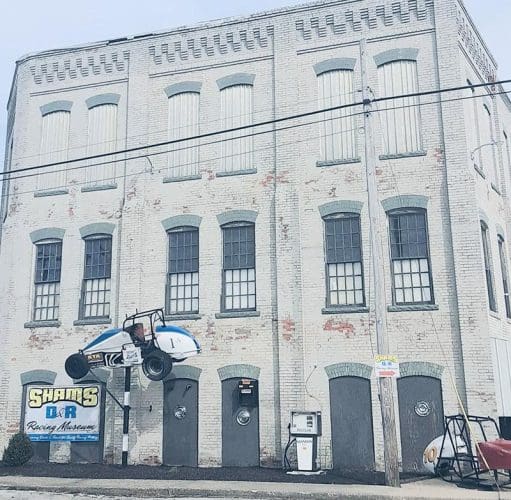
UNION CITY – One village that makes it unique is Union City because it shares two states.
Union City, Ind., was platted in 1849, 11 years after its twin city of Union City, Ohio. The Ohio side of town was first platted in 1838 and again in 1853, the latter by Joseph Monger.
Jeremiah Smith planned the Indiana side of town and recorded the plat for it in 1849. That original plat containing 160 acres was one-half mile square and divided into 252 lots. The plat was altered in 1854 when it was corrected and enlarged with 483 smaller and more numerous plots. That plat, it pointed out, is still in use on the Indiana side today. The area was then called Union.
The community is noted for the William Kerr House, Raphael Kirshbaum Building, Union City Commercial Historic District, Union City Passenger Depot, Union City Public Library, and Union City School, which are listed on the National Register of Historic Places.
One report stated that Union City has a total area of 2.209 square miles, of which 2.2 square miles are land and 0.009 square miles are water.
Union City is a city in Wayne Township of Randolph County, Ind., and, at one point, had a population of 3,454. The population on the Ohio side, which is directly across the state line in Darke County, at the 2020 census was 1,582.
A post office has been in operation in Union City, Ind., since 1852 and also serves the Ohio side of the village.

It is believed by some area residents that the town got its nickname “The Hub City” because the two railroads intersected near the Ohio and Indiana state line.
Union City was a stop along the Pittsburgh, Cincinnati, Chicago, and St. Louis Railroad, a forerunner of the Pennsylvania Railroad that connected Pittsburgh to Chicago and St. Louis. The Cleveland, Cincinnati, Chicago, and St. Louis Railway (also known as the “Big Four”, a predecessor of the New York Central) had the east–west route connecting Indianapolis, Anderson, and Muncie, Ind., with Sidney, Bellefontaine, and Columbus, Ohio.
Information said that in 1848, five separate railroads announced plans to meet at the Ohio–Indiana state line where Union City is now located. Because of this importance, a unique meeting of railroads made the Union Cities the “most important railroad center in the states or even the country” almost overnight.
It is reported that more than 150 railroad employees were in town at the time, and five passenger and 22 freight trains arrived and departed Union City every 24 hours.
Union City was a stop along the Pittsburgh, Cincinnati, Chicago, and St. Louis Railroad, a forerunner of the Pennsylvania Railroad that connected Pittsburgh to Chicago and St. Louis. The Cleveland, Cincinnati, Chicago, and St. Louis Railway (also known as the “Big Four”, a predecessor of the New York Central) had an east–west route connecting Indianapolis, Anderson, and Muncie, Indiana, with Sidney, Bellefontaine, and Columbus, Ohio.
According to information from the souvenir book from the 1974 celebration, it is said evidence shows that the early human settlers of the area were those people now known as the “Mound Builders,” those now extinct people who built burial mounds in this area, which were accidentally excavated while seeking gravel built the State Line Road.
By 1852, Union City saw real activity in the new community. People who began to realize the opportunities provided by this special and unique location began to arrive. News of the railroads had filtered out into the country, and people realized these opportunities began to arrive. Soon, grain, stock, and trade began to pour into the community. And, in as few as three or four years, there were groceries, hardware stores, tin shops, hotels, doctor’s offices, smith shops, and no less than six dry goods stores in the community.
Not only was Union City a vital part of the railroad history of the United States, but it was also instrumental in the origination of the automobile. John William Lambert formed the Union Automobile Company in Union City, Ohio, in 1902, and he is credited with building the country’s first successful horseless buggy.
Lambert reportedly had more than 600-plus patented automotive-related parts that were manufactured to produce the Union automobile. There were approximately 300 autos sold from 1900-05. Also produced were trucks, farm tractors, and fire engines from 1905 to World War I.
Other manufacturing sites in Union City over the years included Backstay Machine in 1898, Reit-Price Manufacturing founded in 1900, Union City Carriage Works in 1915, Garver Manufacturing in 1919, Sheller-Globe in 1940, and the Hardy Division later on, and Westinghouse Electric Corporation in 1952.
In 1910, a Mr. Jefferis, owner of the Union City Coca-Cola Bottling Company, built a new, larger building in the rear of North Union Street to house his new, improved bottling equipment. A sub-franchise was obtained in 1916 from the Dayton, Coca-Cola Bottling Company for rights to bottle Coca-Cola locally. In 1969, those companies were sold to the Coca-Cola Bottling Company of Portland, Ind., and later moved out of Union City.
In 1999, it was noted that the area had been hit hard economically in the previous 25 years in the business industry for various reasons. And, both sides of the village began taking positive steps to renovate their business districts with the help of state and federal aid.
Among those achievements included the Workhorse Custom Chassis facility, UCO Tool and Die, the Union City Retirement Village, and the building of the Rite-Aid drug store, not to mention several downtown buildings getting facelifts.
Additional features on both sides of the village are Harter Park on the Indiana side and Railroad Park on the Ohio side, not to mention all of the businesses that are now thriving in the village on both sides.
For many years, the town has been holding an annual festival, first known as Farmer-Merchant Days and now known as Stateline Heritage Days.
Currently serving as mayors of both sides are Chad Spence in Indiana and Duane Pouder in Ohio.
The community is now gearing up for a special celebration…it’s 175th birthday next month.
Yes, both sides of Union City will be the focus of the four-day celebration.
More on the upcoming 175th Birthday Celebration will be featured on My County Link in a few days.





